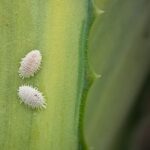Mealybug
Leaf Feeding Insects & Mites
Mealybugs are tiny, soft-bodied insects that belong to the family Pseudococcidae. They feed on the sap of plants and are known to be pests of many agricultural and ornamental crops. Mealybugs are found all over the world and are usually recognizable by their waxy, white cottony appearance.
Mealybugs are often found in clusters on the leaves, stems, or fruit of plants. They insert their long, piercing-sucking mouthparts into the plant tissue to feed on the sap, which is a source of carbohydrates and other nutrients. Mealybugs secrete a sticky, sugary substance called honeydew, which can attract other pests such as ants, flies, and sooty mold.
The feeding of mealybugs can lead to the weakening of plants, stunted growth, reduced yield, and yellowing of leaves. In severe infestations, leaves may drop off, and the plant may die. Mealybugs can also transmit plant diseases such as viral, fungal, and bacterial infections, making them even more dangerous to crops.
There are several methods to control mealybugs, including the use of chemical insecticides, biological control, and cultural control. Chemical insecticides, such as insecticidal soap, neem oil, and pyrethrin, are commonly used to kill mealybugs. However, they can also harm beneficial insects and pose risks to human health and the environment.
Biological control involves using natural enemies of mealybugs, such as ladybugs, lacewings, and parasitic wasps, to reduce their populations. Cultural control involves promoting the health of plants and making them less attractive to mealybugs by providing adequate water, nutrients, and light. Pruning infested shoots and branches, cleaning up fallen leaves and debris, and controlling ant populations can also help reduce mealybug infestations.
In conclusion, mealybugs are persistent pests that can cause significant damage to crops and ornamental plants. Understanding the life cycle and behavior of these insects is essential to developing effective control strategies. A combination of chemical, biological, and cultural control methods can help minimize the damage caused by mealybugs and keep plants healthy.



